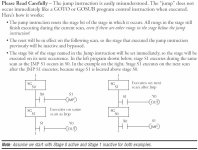thierry2003
Member
- Join Date
- Oct 2003
- Posts
- 70

Since I am trying out the RLL plus programming I found a small problem.
Let's say that stage 1 turns a motor on clockwise.
Lets say that stage 2 turns the same motor on but counter-clockwise.
Both stages use the OUT instruction.
Now, on the end of stage 1 I do a jump to stage 2.
So stage 1 will become inactive and stage 2 will become active.
So, on the end of the scan both contactors (the one to turn clockwise and the one to turn counter-clockwise) will be on!
Since there are wired interlocks on the contactors there will be no real problem but I just don't like it.
What is the best way to solve this?
I could use a stage between 1 and 2 that, after a time, jumps to stage 2 but I am wondering what you experts think.
Thanks
Let's say that stage 1 turns a motor on clockwise.
Lets say that stage 2 turns the same motor on but counter-clockwise.
Both stages use the OUT instruction.
Now, on the end of stage 1 I do a jump to stage 2.
So stage 1 will become inactive and stage 2 will become active.
So, on the end of the scan both contactors (the one to turn clockwise and the one to turn counter-clockwise) will be on!
Since there are wired interlocks on the contactors there will be no real problem but I just don't like it.
What is the best way to solve this?
I could use a stage between 1 and 2 that, after a time, jumps to stage 2 but I am wondering what you experts think.
Thanks





